I came to Georgia for the mountains. Mestia was the plan — quick hike, short stay, move on. But somewhere between the cobbled streets and wine bars, Tbilisi slowed me down.
It’s that perfect in-between kind of city: big enough that you’ll never run out of things to do, small enough that it still feels personal. People greet you like an old friend, and by the third day, you’re slipping into routines — same café, same shortcut, same favourite khinkali spot.
I ended up staying almost a month.
This Tbilisi itinerary pulls from three weeks I spent in the city, moving slowly, eating obsessively, and figuring out which spots are worth your time — whether you’ve got two days or ten. If you’re planning a trip to Georgia, this guide will help you find your footing fast in a city that’s equal parts ancient, artsy, and effortlessly warm.
Quick Trip Planner: Tbilisi at a Glance
🗓️ Best Time to Visit
Spring (April–May) and early fall (September–October) for perfect jacket weather and fewer crowds. Avoid July/August unless you enjoy sweating through your clothes.
📍 How Many Days?
Three full days is a sweet spot — enough to wander, soak, and sip without burnout. More if you’re slow-traveling or using Tbilisi as a base for day trips.
🏡 Where to Stay
Vera: Stylish, central, quiet — like the older sibling who listens to jazz.
Marjanishvili: Boho, budget-friendly, and full of character. I stayed here for a month and loved it.
💸 Budget Range
Shoestring: ~$30–40/day (hostel, khinkali, and Bolt rides)
Mid-range: $60–80/day
Treat yourself: $150+ (boutique hotel, wine tastings, the works)
🚕 Getting Around
Download Bolt and thank me later. Most rides are $1–3. Walking works great in Old Town, and buses are there if you’re feeling brave.
🛂 Visa Tips
Holders of US, UK, EU, UAE resident permits can enter visa-free for up to 30 days. Check current rules — they shift.
⚠️ Safety
Generally very safe, even solo. Petty theft is rare but keep your phone tucked away in crowded areas.
💬 Language
Georgian is the official language, but you’ll find English speakers in most cafés, hostels, and tourist spots. Learn “gamarjoba” (hello) — it goes a long way.
Tbilisi 101: A City on the Edge (of Continents, Eras, and Aesthetic Choices)
Tbilisi, the capital of Georgia, isn’t a city you figure out on day one. It’s layered — sometimes literally, with 4th-century fortresses perched over bougie wine bars and cable cars flying past crumbling Soviet blocks.
Founded in the 5th century by King Vakhtang I (legend says he found hot springs here while hunting — yes, Tbilisi means “warm place”), the city has been conquered, burned, rebuilt, and renamed more times than most capitals can count. Persians, Arabs, Mongols, Russians — everyone wanted a piece of Tbilisi, and it shows.
Today, the city is a delicious clash of eras and empires: Ottoman-style balconies dangle over gritty alleyways. Orthodox domes rise next to brutalist apartment blocks. Stalinist grandeur competes with minimalist wine bars.
It’s also home to about 1.5 million people — most of them friendly, curious, and ready to tell you where to find the best khinkali (spoiler: everyone has a different answer).
Despite the layers of history, Tbilisi doesn’t feel stuck in the past. It’s alive in the best way — a place where students protest in front of Parliament while grandmas sell herbs outside 11th-century churches. A place that wears its scars and stories with surprising warmth.
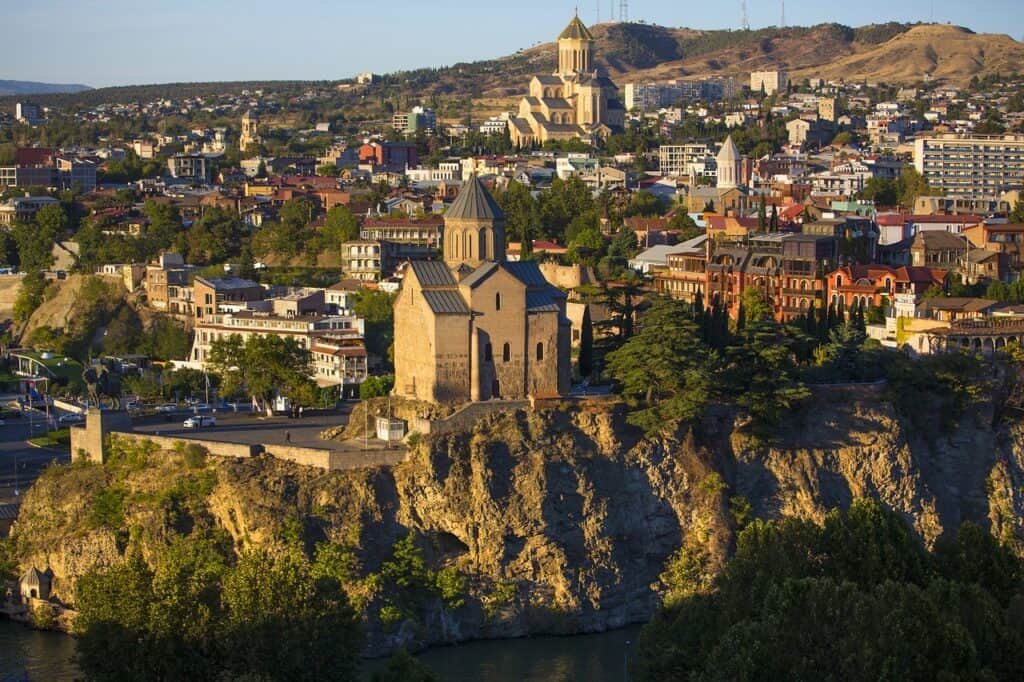
Musafir in Transit contains affiliate links and is a member of the Amazon Services LLC Associates Program. If you book through these links I may make a small commission at zero cost to you. It helps me pay for the upkeep of this blog. Thank you! See the Disclosure Policy for more info.
About this Itinerary
I would recommend at least three days to truly experience Tbilisi, which is how I’ve structured this itinerary. When I spent a month here, I realized how easy it is to get lost in the rhythm of the city. But even if you’ve only got a day or two, start with Day 1 from this guide and work your way up.
If you’re someone who prefers a slower pace, you could even stretch out Day 1 over a couple of days. Whether you’re breezing through or taking it easy, there’s always something in Tbilisi that will surprise you.
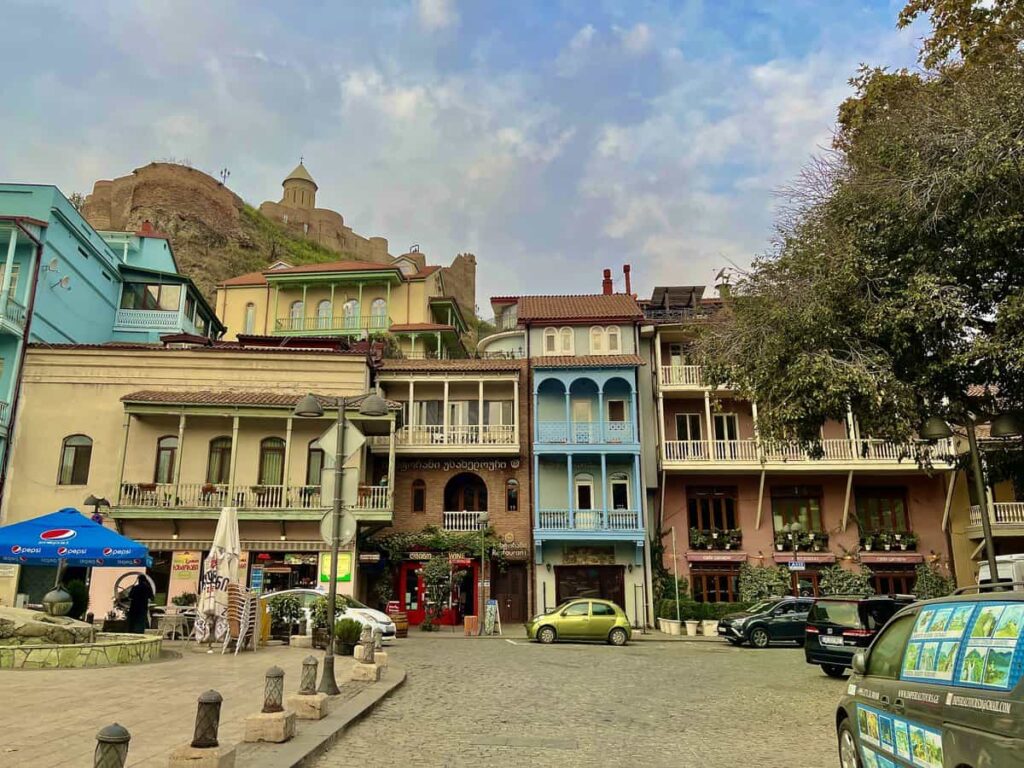
Day 1
We’ll kick off Day 1 by exploring Tbilisi’s Old Town. Even though it may seem like a packed day, don’t worry—most of the spots are pretty close to each other, and you won’t need too much time at each place. Just move at your own pace and take it all in.
Explore the Old Town
Old Town is full of winding streets, colorful buildings, and those little spots that make you feel like you’re discovering something new at every turn. You can get lost in the alleys without worrying—half the fun is just wandering and seeing what you stumble upon.
One of the key stops here is Sioni Cathedral. It’s smaller than some of the other churches you’ll see in Georgia, but it’s a good introduction. You’ll find some fascinating frescoes inside, and if you time it right, you might even catch some haunting chants from the monks.
Clock Tower (Gabriadze Theater)
While you’re walking around, you’ll probably run into the Clock Tower at some point. It’s quirky and definitely stands out—sort of like something from a whimsical storybook. This is more of a quick photo op rather than something you spend a lot of time at, but it’s worth stopping by if you’re nearby.
Oh, and if you happen to be there on the hour, check out the tiny puppet show that happens at the top. It’s one of those little touches that adds charm to the area.
Stroll through Shardeni Street
After checking out the sights, head over to Shardeni Street. This is where the action is—lots of little cafés, bars, and shops to check out. It’s a great spot to grab a coffee, watch people, or try some local food. The street always feels lively, and you’ll find both locals and tourists hanging out here.
It’s also a good place to pick up a souvenir or two. You’ll find everything from traditional crafts to quirky little gifts you didn’t know you needed.
Narikala Fortress
When you’re ready for a bit of a climb, head to Narikala Fortress. This ancient stronghold has been overlooking the city since the 4th century and offers one of the best panoramic views of Tbilisi. It’s a bit of a hike up the hill, but you can also take the funicular if you prefer.
The fortress may not be the most well-preserved, but it’s incredibly accessible, and you can wander around its crumbling walls while taking in breathtaking views of the city and the Mtkvari River. If you have time, visit at sunset—the golden light over Tbilisi is truly magical.
See the Mother of Georgia
On your way down from the fortress, don’t miss the Mother of Georgia statue. She’s kind of hard to miss, towering over the city with a sword in one hand and a cup of wine in the other. It’s meant to symbolize Georgia’s dual nature—welcoming to guests but ready to defend itself.
It’s a great spot for photos and offers another beautiful view of the city below. You’ll see her from various points in Tbilisi, but getting up close is a must!
Sulphur Baths
After a busy day of exploring, it’s time to unwind at Tbilisi’s famous Sulphur Baths. These natural hot springs have been a part of the city’s culture for centuries, and they’re still the perfect place to relax and recharge. The word “Tbilisi” actually means “warm place,” a nod to the thermal springs beneath the city.
There are several bathhouses to choose from—whether you prefer a private room or a public bath, the warm water is the perfect remedy for tired muscles. After your soak, you’ll feel like a new person, ready to tackle the next day’s adventures.
Kura River
If you still have energy left, you can do a boat tour on the Kura river, which is a nice way to see the city from a different angle and get your bearings before moving on to day 2!

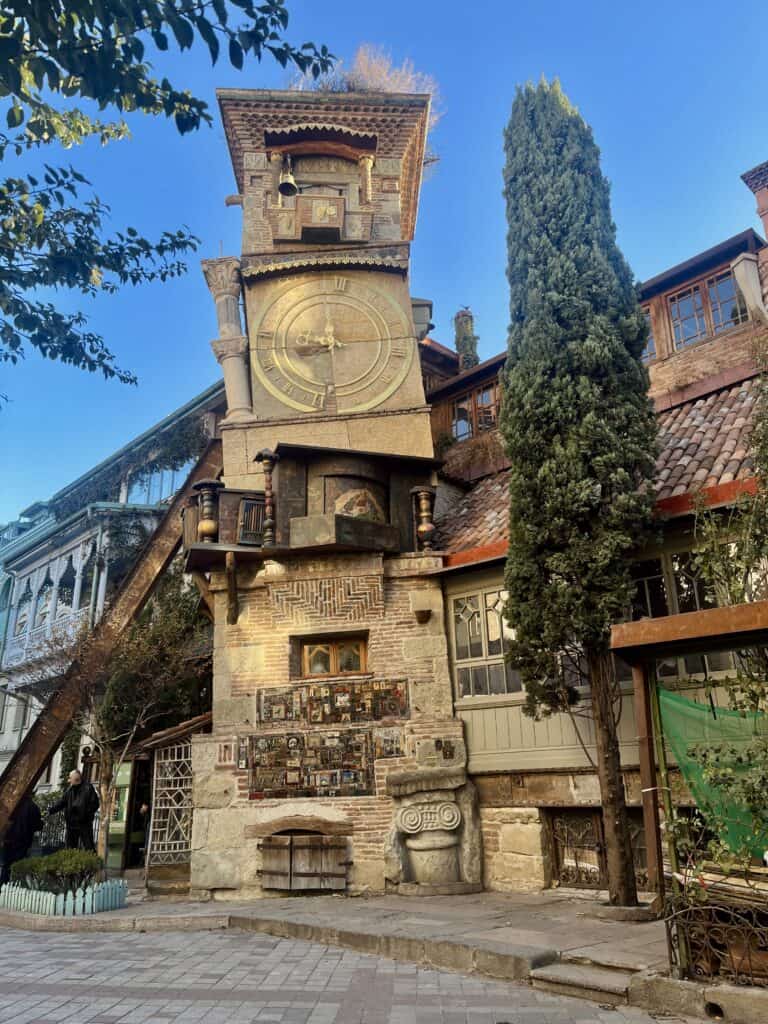
Day 2
Day 2 is going to be a little more laid-back, with less sightseeing and more time spent soaking in the vibe of the city. We’ll explore a few key spots, and end the day with some well-deserved wine tasting.
Explore Sololaki Neighborhood
Sololaki feels like a peek into Tbilisi’s high society of the early 1900s, with streets lined by beautiful homes, narrow alleyways, and those classic wooden balconies that make you feel like you’ve stepped into another time.
The neighborhood is also home to the Georgian National Opera Theater, and if you’re up for it, you can swing by to check out its grand architecture. Sololaki is a great place to see how the city evolved during the Soviet era while keeping its Georgian character intact.
Dry Bridge Flea Market
If you love browsing for unique items, the Dry Bridge Flea Market is an absolute must. It’s been a fixture of Tbilisi since the post-Soviet era in the early 1990s, and you’ll find all sorts of quirky treasures here. We picked up some unique jewelry, colorful glassware perfect for aperitifs, and even a traditional Georgian drinking horn known as a Kantsi.
The market is located at the end of Davit Aghmashenebeli Avenue, which is one of my favorite pedestrian streets in the city. It’s fun just to wander around, even if you don’t buy anything, but I guarantee you’ll be tempted by something.
Sameba Cathedral
If you’re staying at Siberia Hotel like we did, you’re in luck—Sameba Cathedral is practically next door, making it a super convenient stop. This towering structure, also known as the Holy Trinity Cathedral of Tbilisi, is one of the tallest Orthodox churches in the world. It’s impossible to miss, especially with that golden rooftop gleaming in the sunlight.
Inside, you’ll find some beautiful Georgian polyphonic singing if you visit during a Sunday sermon. Even if you’re not religious, the architecture alone is something to admire, and the views from the hill where it stands are worth the visit.
Fabrika
Fabrika is one of those spots in Tbilisi that’s buzzing with creativity. It used to be a Soviet-era sewing factory, but now it’s been transformed into a hipster hub filled with street art, cafés, bars, and quirky shops selling locally made goods. This place is fun to explore at any time of day, whether you’re grabbing a coffee or just wandering around taking in the murals.
I found myself here several times during my stay in Tbilisi. It’s the perfect spot to get a feel for Tbilisi’s artsy side and enjoy a laid-back vibe.
Wine Tasting in Tbilisi
Now, let’s talk about wine. Fun fact—Georgia claims to be the oldest wine region in the world, and it’s something they’re extremely proud of. Whether you’re a wine enthusiast or not, dedicating some time to wine tasting in Tbilisi is pretty much non-negotiable.
You’ll find plenty of wine bars around the city, but if you want to avoid the overly touristy spots, head to a more local place like 8000 Vintages for a thorough tasting experience. It’s a great way to get a feel for Georgian wine culture and end your day on a high note. Trust me, after a day of exploring, a glass of wine (or two) is exactly what you’ll need.

Day 3
Day 3 is a bit more laid-back, giving you time to recover from all the walking (and maybe the wine) from the previous days. If you missed anything, this is your chance to catch up. Otherwise, we’ll explore some unique spots today, and don’t worry, there’s still time to take in one more sunset.
Chronicles of Georgia
One of the lesser-known spots in Tbilisi is the Chronicles of Georgia. I didn’t find out about this online, which makes it feel like a hidden gem. The monument consists of 16 massive pillars depicting Georgia’s history, from ancient kings and queens to biblical stories. It’s a bit out of the way, but if you’re interested in history and striking art, it’s definitely worth the trip.
It’s also a fantastic spot for photos—you’ll likely have the place to yourself, adding to its quiet, almost surreal atmosphere.
Mtatsminda Park
In the afternoon, head up to Mtatsminda Park, which sits at the highest point in Tbilisi. Now, I’m a sucker for sunsets, so this was an easy choice for me—it’s one of the best spots to catch the sun dipping behind the city. There’s also a funicular that’ll take you up, offering panoramic views as you ascend.
I also came here hoping for a roller coaster fix (I hadn’t been to an amusement park in forever), but to be honest, the park itself was a bit underwhelming. However, the view and the wine you can sip while overlooking the city? Totally worth it.
Attend a Traditional Georgian Dance Performance
To round off your day, why not dive into a bit of Georgian culture by attending a traditional dance performance? You’ll see performers in colorful costumes showing off some seriously intricate footwork, with dances that have been passed down through generations. Check the schedule at the Marjanishvili Theater or the Rustaveli National Theater to catch a show—it’s a fantastic way to end your Tbilisi adventure.
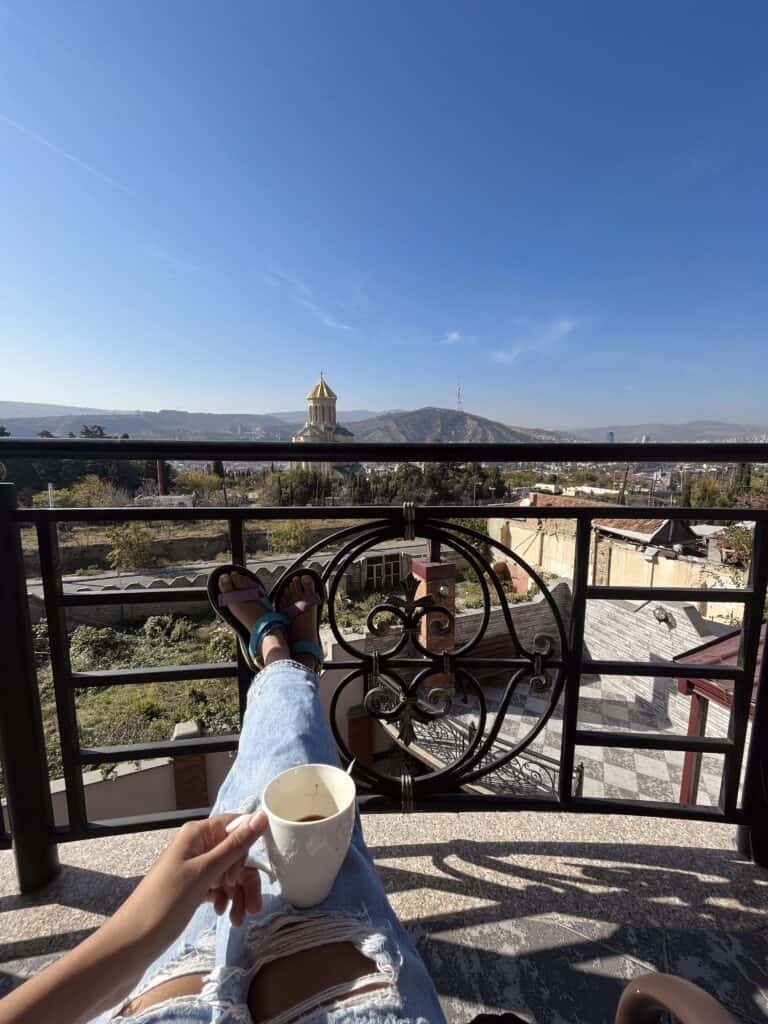
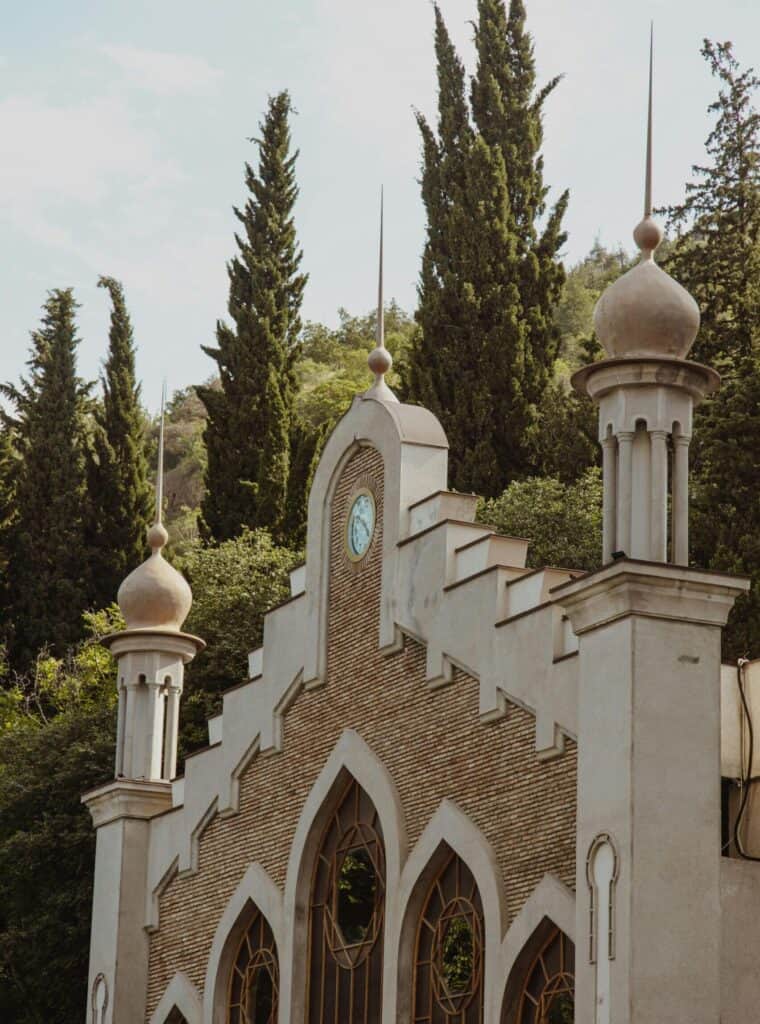
Day 4 (Optional) – Day Trips from Tbilisi City
If you have extra time in Tbilisi, I highly recommend a day trip to explore a bit more of what Georgia has to offer. Tbilisi is in the perfect spot for quick escapes to nearby regions, without having to travel too far. Here are my top three picks for day trips from Tbilisi:
Kakheti Wine Region
If you’re into wine (or even if you’re not), a tour of the Kakheti Wine Region is a must. I did this tour myself, and it was perfect—because let’s be honest, after a few glasses of wine, the last thing you want to worry about is logistics. Kakheti is the heart of Georgia’s winemaking, and it’s where you’ll learn about Georgia’s ancient wine traditions while sampling some of the best wines the country has to offer.
The tour takes you through places like Sighnaghi, aka the “City of Love,” and Khareba Winery, where you’ll get to explore wine cellars built into tunnels. They’ll also throw in some stops for Georgian bread and cheese—because what’s wine without a little food? It’s a perfect day of sipping, learning Georgian history, and enjoying countryside.
Day Trip to Mtskheta
If you’re more into history and culture, a guided tour to Mtskheta is another solid option. Mtskheta is one of Georgia’s oldest cities and a UNESCO World Heritage site, so it’s a great way to dive into the country’s past. Plus, if you do this tour, you can skip visiting the Chronicles of Georgia on your own, as it’s already part of the itinerary.
You’ll visit Jvari Monastery and Svetitskhoveli Cathedral, both of which are beautiful and packed with history. Jvari Monastery offers stunning views, and you’ll also get some time to relax in Mtskheta before heading back to Tbilisi. It’s a nice mix of culture and chill.
Exploring Kazbegi National Park
For those who need a mountain fix, a day trip to Kazbegi National Park is perfect. The landscapes are breathtaking, but if you’re already planning to visit the Svaneti region, you might want to skip this, as you’ll see plenty of the Caucasus Mountains there too.
This tour takes you up the Georgian Military Highway, stopping at spots like the Zhinvali Reservoir and Ananuri Fortress along the way. One of the highlights is the Holy Trinity Gergeti Monastery, which sits on a hill with Mount Kazbegi looming in the background. It’s the kind of view that makes the journey worth it.
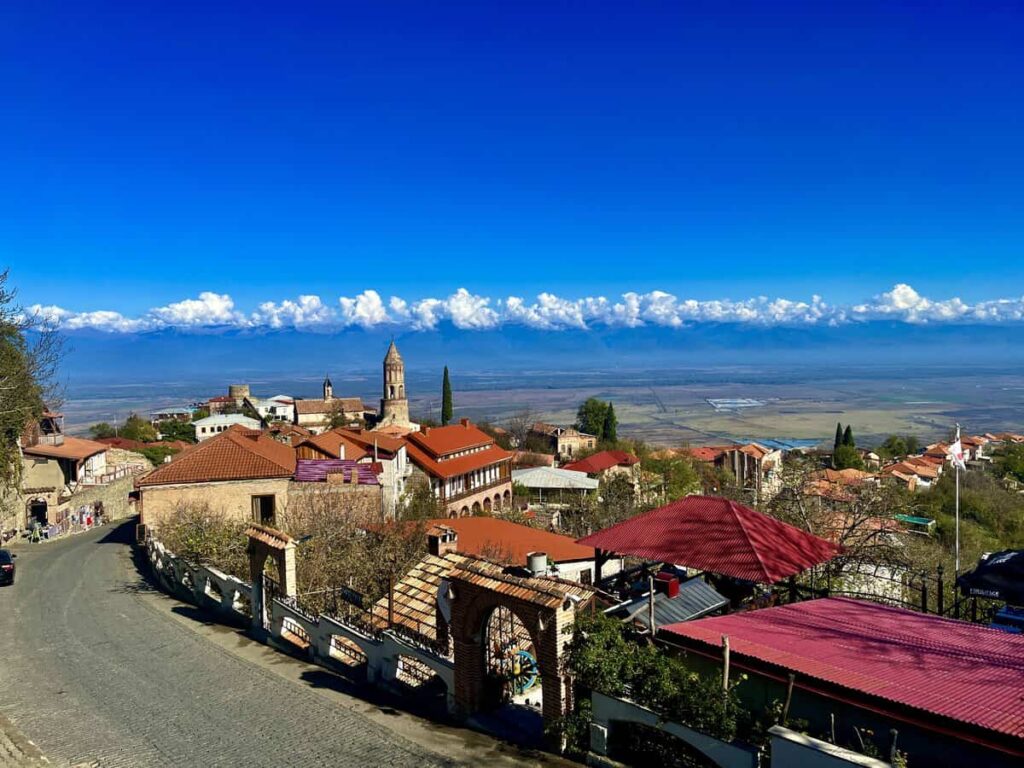
Tips for Visiting Tbilisi
Visa Requirements: I always make a point of checking visa requirements, especially since having a Pakistani passport can make things tricky. For Tbilisi, residents of the USA, UK, EU countries, and most Middle Eastern countries can enter Georgia with a valid resident permit for up to 30 days. Always check the latest visa requirements based on your nationality before traveling.
Currency: The local currency in Georgia is the Georgian Lari (GEL). You can exchange currency at the airport, but you’ll likely get better rates at exchange offices around the city. Keep some cash on you, as not all places in Tbilisi accept card payments, especially in smaller shops or markets.
How to Avoid Tourist Traps: Avoid restaurants and shops that seem too touristy—especially around popular landmarks like the Sulphur Baths, Rike Park or Liberty Square. Instead, seek out smaller, local spots where the prices are fair, and the food is more authentic. Don’t be afraid to walk a few extra blocks away from the main tourist areas for a more genuine experience.
Language: Georgian is the official language, but in Tbilisi, many locals also speak Russian or English, especially younger generations and those working in tourism. It’s always a good idea to learn a few basic Georgian phrases—locals really appreciate the effort.
Food to Try: I can’t tell you how much I’m craving khinkalis as I’m writing this. These dumplings are a must-try in Tbilisi, but don’t stop there. Georgian food is all about hearty, flavorful dishes. Try khachapuri (cheese-filled bread), lobio (bean stew), and churchkhela (candy made from nuts and grape juice). Georgian cuisine is incredibly diverse and delicious!
Final Thoughts
Tbilisi is one of those cities that pulls you in and doesn’t let go—I know I left a bit of my heart there and can’t wait to go back. Whether you’re exploring for three days or more, this city’s mix of history, culture, and warmth will stay with you long after you’ve left.
I hope you fall in love with this city just as I did.
If you’re heading to other parts of Georgia, don’t miss my guides to Svaneti for even more travel inspiration.
Frequently Asked Questions
How many days are enough in Tbilisi?
A minimum of three days is enough to get a good feel for Tbilisi, but you can easily spend more time here exploring its many neighborhoods, historical sites, and food spots. If you prefer a slower pace, stretching your stay is a great idea.
Is Tbilisi better than Batumi?
Yes, I found Tbilisi to be much more authentic compared to Batumi, which felt more like a tourist-made destination. Tbilisi offers a deeper cultural experience and a unique blend of history and modern life.
Is it expensive to visit Tbilisi?
Visiting Tbilisi can suit a range of budgets. For budget travel, expect to spend around $30-40 per day. Mid-range travelers might spend $60-80 per day, while high-end travelers could spend $150+ depending on accommodation and dining choices.
